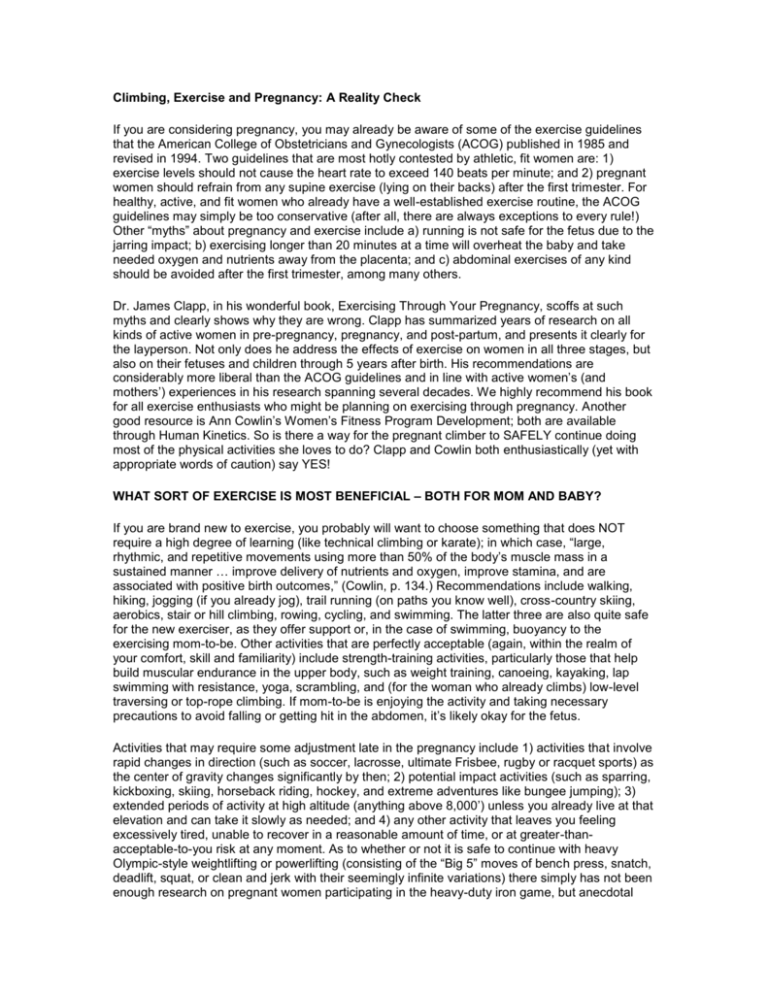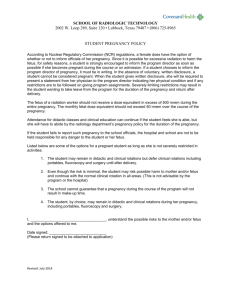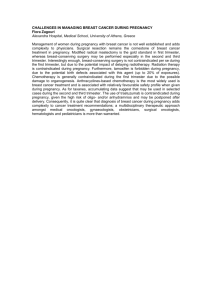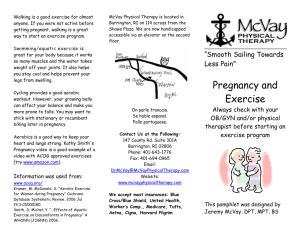Climbing, Exercise and Pregnancy: A Reality Check
advertisement

Climbing, Exercise and Pregnancy: A Reality Check If you are considering pregnancy, you may already be aware of some of the exercise guidelines that the American College of Obstetricians and Gynecologists (ACOG) published in 1985 and revised in 1994. Two guidelines that are most hotly contested by athletic, fit women are: 1) exercise levels should not cause the heart rate to exceed 140 beats per minute; and 2) pregnant women should refrain from any supine exercise (lying on their backs) after the first trimester. For healthy, active, and fit women who already have a well-established exercise routine, the ACOG guidelines may simply be too conservative (after all, there are always exceptions to every rule!) Other “myths” about pregnancy and exercise include a) running is not safe for the fetus due to the jarring impact; b) exercising longer than 20 minutes at a time will overheat the baby and take needed oxygen and nutrients away from the placenta; and c) abdominal exercises of any kind should be avoided after the first trimester, among many others. Dr. James Clapp, in his wonderful book, Exercising Through Your Pregnancy, scoffs at such myths and clearly shows why they are wrong. Clapp has summarized years of research on all kinds of active women in pre-pregnancy, pregnancy, and post-partum, and presents it clearly for the layperson. Not only does he address the effects of exercise on women in all three stages, but also on their fetuses and children through 5 years after birth. His recommendations are considerably more liberal than the ACOG guidelines and in line with active women’s (and mothers’) experiences in his research spanning several decades. We highly recommend his book for all exercise enthusiasts who might be planning on exercising through pregnancy. Another good resource is Ann Cowlin’s Women’s Fitness Program Development; both are available through Human Kinetics. So is there a way for the pregnant climber to SAFELY continue doing most of the physical activities she loves to do? Clapp and Cowlin both enthusiastically (yet with appropriate words of caution) say YES! WHAT SORT OF EXERCISE IS MOST BENEFICIAL – BOTH FOR MOM AND BABY? If you are brand new to exercise, you probably will want to choose something that does NOT require a high degree of learning (like technical climbing or karate); in which case, “large, rhythmic, and repetitive movements using more than 50% of the body’s muscle mass in a sustained manner … improve delivery of nutrients and oxygen, improve stamina, and are associated with positive birth outcomes,” (Cowlin, p. 134.) Recommendations include walking, hiking, jogging (if you already jog), trail running (on paths you know well), cross-country skiing, aerobics, stair or hill climbing, rowing, cycling, and swimming. The latter three are also quite safe for the new exerciser, as they offer support or, in the case of swimming, buoyancy to the exercising mom-to-be. Other activities that are perfectly acceptable (again, within the realm of your comfort, skill and familiarity) include strength-training activities, particularly those that help build muscular endurance in the upper body, such as weight training, canoeing, kayaking, lap swimming with resistance, yoga, scrambling, and (for the woman who already climbs) low-level traversing or top-rope climbing. If mom-to-be is enjoying the activity and taking necessary precautions to avoid falling or getting hit in the abdomen, it’s likely okay for the fetus. Activities that may require some adjustment late in the pregnancy include 1) activities that involve rapid changes in direction (such as soccer, lacrosse, ultimate Frisbee, rugby or racquet sports) as the center of gravity changes significantly by then; 2) potential impact activities (such as sparring, kickboxing, skiing, horseback riding, hockey, and extreme adventures like bungee jumping); 3) extended periods of activity at high altitude (anything above 8,000’) unless you already live at that elevation and can take it slowly as needed; and 4) any other activity that leaves you feeling excessively tired, unable to recover in a reasonable amount of time, or at greater-thanacceptable-to-you risk at any moment. As to whether or not it is safe to continue with heavy Olympic-style weightlifting or powerlifting (consisting of the “Big 5” moves of bench press, snatch, deadlift, squat, or clean and jerk with their seemingly infinite variations) there simply has not been enough research on pregnant women participating in the heavy-duty iron game, but anecdotal reports from several women indicate that they were able to safely continue with almost all of their lifts, simply adjusting the weight as needed and listening closely to their bodies. IS IT SAFE TO CLIMB DURING PREGNANCY? Climbing can continue just as before during the first trimester, if the mom-to-be is comfortable doing so through bouts of morning sickness. After the first trimester when the abdomen starts to protrude, there is increased risk of trauma to the fetus in terms of 1) harness pressure, 2) rock (or object) fall, or 3) leader fall. The easiest solutions: 1) wear a full-body or specially designed harness that will ride lower across the abdomen rather than directly across the belly button; 2) climb in areas with solid rock and avoid more questionable crags or alpine routes that are notorious for rock fall, slab avalanches, or climbers dropping gear from above; 3) follow rather than lead; 4) climb familiar routes; 5) boulder or traverse low to the ground; or 6) focus on less technical climbs well within your ability, in order to remain safe but still have fun. Besides external factors, there are internal factors to think about when climbing. As you gain weight, you may be more susceptible to finger and elbow tendon injuries or strains if you continue to push as hard as you have before. Just as you would train when you are not pregnant, be well aware of joints and tendons and try to avoid “the pump.” Back off whenever you need to and stretch frequently. Furthermore, as you gain weight, you’ll notice that your center of gravity shifts upwards and forward; be sure to stretch muscles that get shortened during pregnancy (lower back, chest, and hip flexors) and strengthen muscles that get overstretched (hamstrings, glutes, abdominals and upper back). Especially important for pregnant women who climb, then, is balancing out the over-utilized lats, the primary upper body muscles involved in vertical climbing, by including stretches such as the doorjamb chest stretch and yoga triangle pose, and strengthening exercises such as seated rows (targeting the rhomboids) and reverse corner pushups (for the posterior deltoids). Finally, remember that with all the relaxin hormone your body is creating (to help release of the baby through the birth canal) now is a perfect time to develop greater flexibility and focus on learning relaxation and breathing techniques that will help in childbirth. Yoga and water aerobics are some options that are perfect for nearly all pregnant women, whether they’ve exercised prior to pregnancy or not. By continuing your flexibility training after childbirth, you may find that you can climb even better post-pregnancy because of your increased range of motion. EXCEPTIONS TO THE ACOG GUIDELINES Heart Rate Below 140? The ACOG guidelines are certainly safe for everyone, including the general, rather sedentary population; however, those women who are used to more aggressive exercise programs need not do away with their programs simply because they’re pregnant. Each and every pregnancy is different, and each woman needs to work closely with her obstetrician to find an exercise plan that will work for her, for her favorite exercise, and for her lifestyle. To limit an athlete, runner, or climber who can easily and safely get her heart rate up to 165 beats per minute or higher to shift her training downwards, for nine months, below 140 bpm would probably cause more harm to the woman’s long-term health and mental psyche than good! According to Clapp: “A heart rate of 180 or more – a racing heart – during high-impact aerobics in early pregnancy is normal for most women but would be unusual in a fit woman late in pregnancy; likewise an exercise heart rate of 130 to 140 during late pregnancy in a fit woman who trains 5 to 7 hours a week is not uncommon when she is working in excess of 70 percent of her maximum capacity.” Women will find that their heart rate changes significantly depending on the trimester. While the body is adapting to the new life inside, the circulatory system is more challenged, so the heart rate tends to be higher both at rest and during workouts in the first trimester. During the second trimester, the heart rate returns more closely to “normal”, and in the third, it may be increasingly difficult to get the heart rate up high enough, doing the same work load (Clapp, pp. 18-25.) Furthermore, using heart rate ONLY may not be appropriate due to the many factors that can influence heart rate at any given time, including age, hydration, resting heart rate and time into a workout, whether the exercise is weight-bearing or supported (aerobics or running versus swimming or biking) and exercise environment (humidity, temperature, etc.) The pregnant woman who is an experienced exerciser and used to using a heart rate monitor to measure intensity may be right at home; others may find it easier to use a subjective rating of how they’re feeling (or Rate of Perceived Exertion) and vary intensity from day to day. Interested in getting your own heart rate monitor? Learn more Supine Exercise? ACOG recommends that women avoid any supine (lying on the back) exercise after the first trimester due to increased pressure of the placenta on the venous system and affect on blood return to the heart. However, in numerous anecdotal reports from active women who continued to include anywhere from 1-5 minutes of abdominal exercise in their routines, Clapp was unable to find any detrimental effects to mom or to the fetus. If you choose to do supine exercises, keep your knees bent and feet either flat on the floor or (if doing a bench exercise) on the bench, to keep proper alignment and a neutral spine. Another option is to do exercises lying on your side, which is the preferred position for resting and for optimal blood flow during pregnancy. More common are reports of problems for women standing for long periods of time; with relative inactivity (standing still, as in sales, cashiering or service) blood pools in the legs and has difficulty returning to the heart, yet nowhere in the guidelines does ACOG caution women against spending significant amounts of time motionless on their feet. DISPELLING THE MYTHS Will intense exercise be too exhausting to the fetus? If you are at all concerned at any time during your pregnancy, consider monitoring fetal heart rate and recovery; if the fetus remains quiet and motionless beyond 30 minutes following exercise (beyond the first trimester), or the fetal heart rate falls too low or remains too high, then you will want to adjust subsequent workouts and monitor the fetal response regularly. Clapp insists that “Regular exercise during pregnancy has positive effects on the growth and function of the placenta that help to protect the fetus from oxygen deprivation…By developing more quickly, more oxygen and nutrients can reach the fetus, better protecting it (than the non-exercising woman under similar circumstances) in those times when the mother may be under stress (such as during heavy exercise).” (Clapp p. 32) Will increasing the core temperature through intense workouts harm the fetus? Actually, the pregnant female becomes very efficient at dispelling heat through the lungs (increased blood volume, better circulation, and higher rate of breathing means more heat lost through respiration) and skin (the “pink glow” from lowered temperature required to start sweating, and increased surface area from which to lose heat) due to adaptations from pregnancy (Clapp, pp 34-36.) As long as the woman is not exercising at extremely high exertion, stays well hydrated, and pays close attention to her training environment (i.e. avoiding really humid or hot conditions) heat affecting the fetus should not be a concern. What effects will exercise have on those active or competitive women who maintain their pre-pregnancy levels of exercise? According to Clapp (p.31), combining training with pregnancy enhances the heart and blood volume to the point where a woman can actually experience an increase of 5-10% in her aerobic capacity; this “training effect of pregnancy” becomes more apparent 6-12 months after birth. This is actually quite similar to what is referred to as “blood doping” in sport! While the speed, intensity, or distance might decrease as a woman advances in her pregnancy, the woman’s CAPACITY to do more actually increases; stopping or reducing exercise during pregnancy will reduce the training benefits post-pregnancy. Can exercise help with labor and delivery? Most definitely! “The woman who continues regular, sustained exercise until the onset of labor usually delivers five to seven days earlier than a woman with an active lifestyle who does not exercise regularly” and furthermore, those women who exercise for the duration of the pregnancy have leaner, lighter (but just as healthy) babies than those who either don’t exercise at all or who stop midway through the pregnancy. Clapp also found in studies of babies 1 and 5 years after birth that those babies whose mothers remained active throughout their pregnancy were generally more alert, leaner, and performed better on various tests; whether that was a factor of exceptional fitness conditions in the womb, or life choices of the parents before and after the pregnancy, could not fully be tested. But most women would probably opt for providing the safest, healthiest womb possible in order to have a lean, smart, and healthy baby. Safe exercise during pregnancy may very well be the key!








